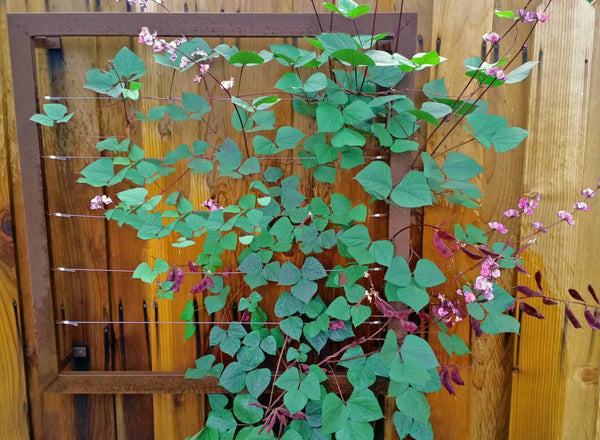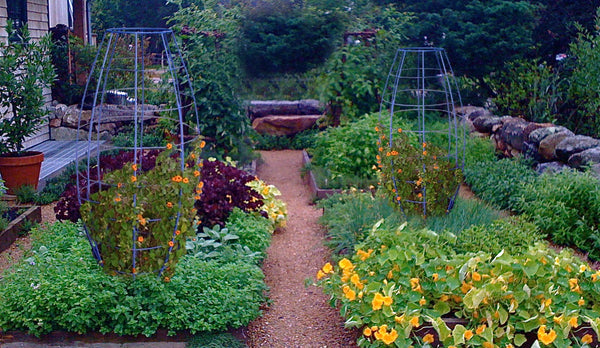Vertical gardens and green walls are enjoying hearty resurgence thanks to the greening of outdoor urban areas, and indoor spaces. Living walls, trellises, vine covered arbors, wall gardens—these structures are all being used to integrate and coexist with architecture, especially in areas lacking access to nature. Though not a new idea (just look at the European wall gardens and ivy-covered cottages), we continue to uncover the enormous benefits of greenery on our health and environment. Updates to materials and modern aesthetics are taking the vertical gardens of the past and integrating them into the spaces and architecture of today.

Above: Classic green walls have beautified exterior walls of European buildings for centuries, like this one in an ancient village in France.

Above: A modern-day version of a European green wall designed by Patrick Blanc, at the CaixaForum museum and cultural center in Madrid, Spain.
Nature as Art
The most obvious benefit of a vertical garden is the captivating visual affect when architecture and greenery integrate. While the motivations behind vertical gardens range from art and design to more practical applications like privacy, the outcome is always something beautiful and inviting. Patrick Blanc, a French botanist and modern innovator of the green wall, is renowned for his lush, sculptural wall gardens that grace buildings around the world. Nature as art is growing in popularity as the desire for natural, functional spaces increases in urban areas.
Above: A Madagascar Jasmine integrates with an Ina Wall Trellis in Venice Beach, California, creating a green wall that looks like a modern organic tapestry.
Growing up instead of out saves space in tight urban areas; garden structures like arbors and trellises can create drama and a sense of seclusion, or bring height and depth to small spaces. Vertical greenery can hide unsightly structures, create privacy screens, and even block noise. Practically speaking, trellises employ the useful beauty of clinging vines without the adherence to the building walls (this can weaken the structure). Today, planned and purposeful vertical gardens make use of artists, designers, landscape architects, architects, and irrigation consultants to best utilize space and native plants.

Above: The Purple Hyacinth Bean proves a gorgeous choice for this weathered steel Ina Wall Trellis. Showy flowers and colorful pods create a vertical garden tapestry attractive to butterflies and bees.
Environmental Benefits
Stanley Hart White (brother of E.B. White) was a professor of Landscape Architecture at the University of Illinois and the inventor of the green wall. His original creation was called “Botanical Bricks” and since Hart's invention, we have observed the enormous environmental benefits of greenery in urban spaces and use has exploded in the last decade.
On the outside of buildings, a layer of vegetation can both protect and insulate a building from the elements and help regulate temperature by cooling and shading the area. The garden may additionally be used to filter water, grow food sources, or sustain a variety of plants, pollinators, insects, and bird species. Within an urban area, green walls and vertical gardens reduce heat build up called insolation, block out noise, increase real estate value, and scrub the air of pollution and CO2. Indoors, vertical gardens improve physical and mental health by removing VOCs and other harmful toxins from the air, as well as tapping into the positive connection between nature and wellbeing.

Above: An edible grapevine is trained to grow up and over a Gracie Modern Arbor in the test gardens of Sunset Magazine.
Productive harvests & practical gardening
Accessibility is another important advantage of vertical garden. Connecting with nature has positive effects on everyone (and proven especially beneficial for those in healthcare facilities). Both plants and people benefit from elevating plants off the ground.
Garden structures like trellises, arbors, tipis, and arches lift plants off the ground to a height accessible to those who cannot bend down, making the plants easier for everyone to harvest and enjoy. In addition, harvests will be more productive and healthy; plants get more sun and concentrated energy for producing food when off the ground with better circulation and fewer pests. Vertical gardens make the most of small spaces, so you can grow a bounty of food even on small square footage (or in the case of our wall trellises, almost no square footage). These same structures can also create microclimates that suit sun-loving plants above and shade-loving plants below, as well as provide shade and refuge for people and animals.

Above: A San Juan Melon is trained to grow vertically over our Gracie Modern Arbor in a greenhouse food forest in Austin, Texas. Elevating the edible plant makes it more productive and harvesting the fruit is easier.
Our steel trellises, tipis, and arbors are engineered for stability and scale, and modernized for today’s environmental and structural needs. TerraTrellis designs work in almost any setting or space because we believe everyone should reap the valuable benefits and beauty of vertical gardens.
Above: Toki Bubble Trellises support ornamental vines in this organic veggie and herb garden in Martha's Vineyard, Massachusetts.

